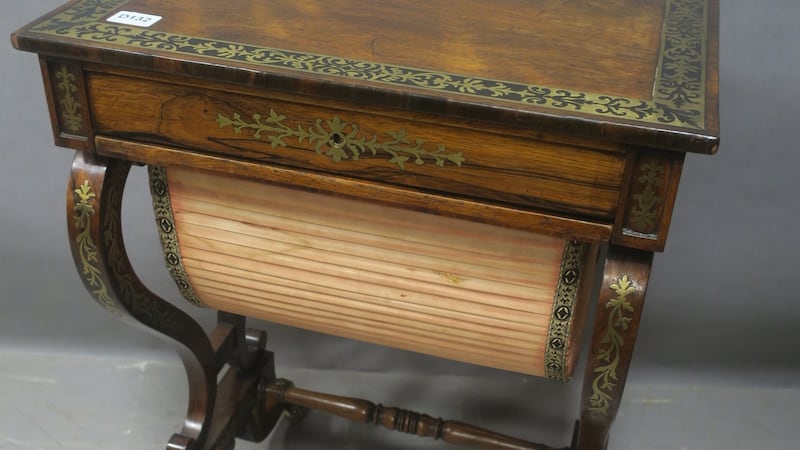Mullen's of Laurel Park forthcoming auction on April 1st will feature more than 650 lots which include a wide selection of period furniture. Of interest is lot 205: a Regency rosewood and brass inlaid work table (€2,400-€2,800) and a signed sideboard by James Hicks of Pembroke Street in Dublin. Hicks was considered to be one of the most admired and proficient cabinetmakers at the turn of the last century.
In 1928, he was commissioned to furnish the Dáil and Seanad at Leinster House, and King Edward VII was a collector, as was his daughter Princess Victoria. In the early 2000s his work sold at auction for multiples of their estimates, whereas now they are considered to be good-value items for collectors (lot 379: €2,000-€3,000).

One of the highlights, and sure to attract international attention, is lot 274: a full set of Irish elk antlers.
Though neither Irish nor an elk, Megalcoerus giganteus is commonly known throughout the world as the Irish elk, simply because of the numbers found preserved in Irish bogs – most notably Ballybetagh bog, south of Dublin.
More recent scientific discoveries have found the animal was in fact a deer – the largest species ever to exist, and closely related to the diminutive fallow deer residing at the Phoenix Park.
The pride of Irish paleontology, these huge creatures weighing up to 700kg – with antlers spanning up to more than four metres and weighing up to 40kg – roamed the middle latitudes of Eurasia until somewhere between 10,000BC and 7,000BC.
Reasons for their extinction are still debated by scientists. Climate change theories suggest that with the advent of warmer weather and prolific tree canopies that developed, the animals were unable to access undergrowth – and necessary nutrients, due to the sheer size of their antlers.
Hunters
Stone Age hunters were also held accountable for their demise, as was the increased size of their antlers due to sexual selection. In the cervine world, it is the antlers that females find attractive – and by which they judge the prowess and strength of their stags. The antlers, it is suggested, grew unwieldy – hence too heavy for the deer to support, also resulting in drownings in bogs and rivers.
The discovery of Irish elk antlers in Lough Neagh last year, by local fisherman Raymond McElroy, proved much more rewarding than his other catch of the day.
Prized as trophies, these prehistoric animal crowns have graced the walls of private manor homes and castles for centuries, and have fetched astonishing prices at auction in the past two decades.
Last year, antlers measuring 2.9m in diameter, which hung in the halls of Dromoland and Bunratty castles, achieved €47,000 at Adam’s on St Stephens Green. The highest price for a set of antlers was achieved in 2006, when Christie’s sold a set from Newbridge House in Dublin for £57,360

The span of the antlers, the number of points (or tines) and level of damage are factors which determine their value. The antlers at Mullen’s have 19 points, with a 1.64m span and have an estimate of €8,000-€12,000.
Interestingly the Irish elk, immortalised in Seamus Heaney’s poem Bogland, is listed on the de-extinction list of species on Mother Nature Network, a website devoted to the sustainability of species.
While cloning is still in its infancy, scientists believe it is only a matter of time before it becomes viable. Until then, the full Irish elk skeleton at the Natural History Museum in Dublin, whose antlers stretch to four metres, is worth a visit. See mullenslaurelpark.com and museum.ie












